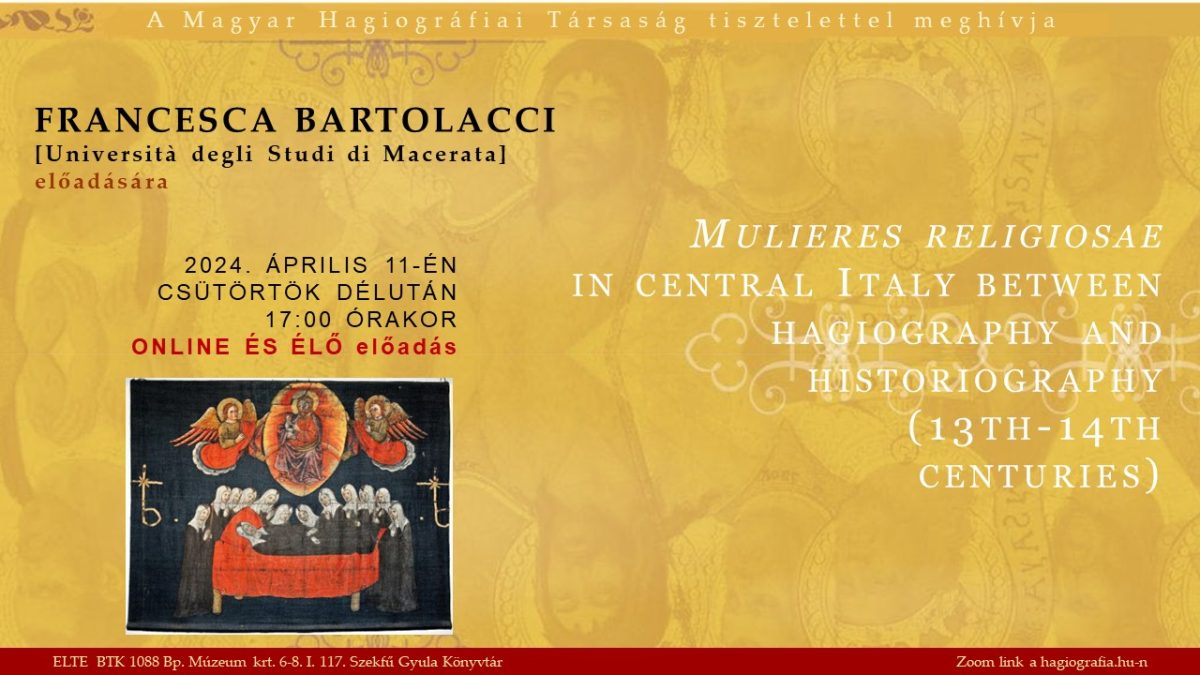The Hungarian Association for Hagiography cordially invites you
Francesca Bartolacci
Mulieres religiosae in central Italy between hagiography and historiography (13th-14th centuries)
April 11, 2024
Thursday
5 pm
Venue: ELTE Szekfű Gyula Könyvtár 1088 Bp. Múzeum krt. 6-8. I. 115.
Zoom link:
https://ceu-edu.zoom.us/j/93068030643?pwd=NTFCVXpzaXUwcUV2V3lSTFZGcVJmdz09
Meeting ID: 930 6803 0643
Passcode: 175393

Mulieres religiosae in central Italy between hagiography and historiography (13th-14th centuries)
The report intends to present two examples of female hagiography in central Italy: Saint Sperandia (or Sperandea) in Cingoli, in the province of Macerata, and Blessed Mattia of Matelica, in the province of Ancona, who lived between the 13th and 14th centuries and whose cult is still alive and
has survived to the present day. The path to a full understanding of these two female holy figures will get through an investigation of the “polycentric” context of the Marche region and the female religious movement (late 12th century – mid 14th century), highlighting how the subsequent historiographic reading has not been free of stereotypes. Finally, these examples will be placed within the historical-institutional events of the towns in which the cult flourished.
Francesca Bartolacci is a historian of the Italian Middle Ages. She deals mainly with the religious history of women and the history of the medieval towns. She is currently a researcher (RTDB) at the University of Macerata, Italy.
Az előadás a közép-itáliai női hagiográfia két példáját kívánja bemutatni: Szent Sperandiát (vagy Sperandeát) és Matelicai Boldog Mattiát, akik a 13-14. században éltek, és akiknek kultusza a mai napig fennmaradt és elevenen él. E két női szent alakjának teljes megértéséhez az út Marche régió “policentrikus” jellegének és az ottani női vallási mozgalmaknak (12. század vége – 14. század közepe) együttes vizsgálatán keresztül vezet, amely rávilágít arra is, hogy a későbbi történetírás sem mentes a sztereotípiáktól. Végül ezeket a példákat azon városok történeti és intézményi változásai kontxtusába helyezzük, amelyekben a kultusz virágzott.
Mulieres religiosae nell’Italia centrale tra agiografia e storiografia (secoli XIII-XIV)
La relazione intende presentare due esempi di agiografia al femminile dell’Italia centrale: santa Sperandia (o Sperandea) a Cingoli, nella provincia di Macerata, e la beata Mattia di Matelica, nella provincia di Ancona, vissute tra il XIII e il XIV secolo, il cui culto è ancora vivo ed è arrivato fino ai giorni nostri. Il percorso per comprendere appieno queste due figure di santità femminile sarà fatto attraverso un’indagine del contesto “policentrico” della regione Marche e del movimento religioso femminile (fine del XII secolo- metà del XIV secolo), evidenziando come la successiva lettura storiografica non sia stata esente da stereotipi. Infine tali esempi verranno collocati all’interno delle vicende storico istituzionali delle città in cui il culto fiorisce.
